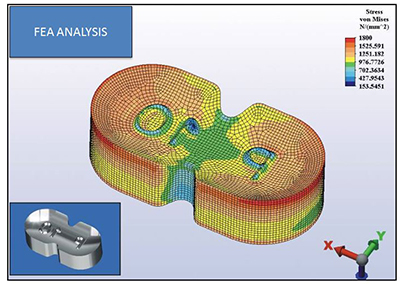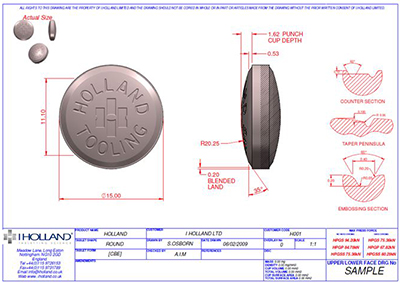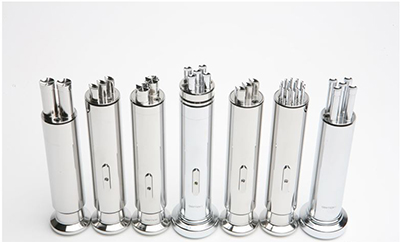Efficiency in solid dose manufacturing can be improved at the earliest stages of the tablet design process by utilising precise tooling specifications.
The design and material selection can have a major influence on the final product. With the help of a quality tooling manufacturer to identify specific requirements, the elimination of downstream tableting problems can be achieved.
It is important to implement an effective tooling specification for a number of reasons, including reducing the time to market by addressing specific product challenges and preventing non-conforming product that will ultimately reduce costs through QbD and result in a faultless end product.
Complex designs and the effect on tooling
Tablets are becoming more complex and unusual in both shape and profile (Figure 1). As the tablets become more intricate, so does the tooling, putting higher demands on strength, durability and overall performance.
This has to be a major consideration when designing a tablet and brings us to the next important factor that needs to be discussed with the manufacturer: the press and tooling equipment.
Tablet tooling has to combine intricate design and functional requirements to ensure that productivity and durability are at their maximum during manufacturing.
To follow this important process, tool coatings are commonly used prevent tablet punch and die wear and solve sticking issues. It is important to remember that punches and dies are the most critical interface with your end product, the tablet, so using the correct material and coating is imperative.
Tooling performance
When looking at tooling performance, consideration should be taken for the tools’ ability to manufacture tablets that are representative of a manufacturer’s requirements and product yield.
There is little point in selecting a design that will not stand up to the demands of tablet production. The following should be considered when designing the product:
- are the fitting processes controlled for designs that require delicate handling and set up?
- is the choice of tooling material and coating appropriate for the formulation being compressed?
- once a cycle is completed, are the tool maintenance procedures optimised to ensure prolonged tooling life?
- can the design withstand prolonged cyclic loading and fatigue to produce a well compacted tablet? This is particularly important when specifying a requirement for multitip tooling.
These questions are important to ask and also lead to examining any tooling management that may have been implemented. In pharmaceutical production, for example, the importance of efficiency and accuracy in managing and monitoring tooling is paramount. Without a system that controls the procedure effectively, there can be adverse effects to the bottom line.
By installing a system that allows tablet manufacturers to keep a record of the tablets being produced — from quantity to batch information — production can run efficiently. There are innovative systems out there that can incorporate this whilst including in-depth guides to tooling specification and troubleshooting, so any problems are flagged up and rectified quickly, resulting in increased productivity, saving both time and money.
Finite element analysis
Stress and fatigue analysis of a punch tip should be considered by using Finite Element Analysis (FEA). Quality tablet tooling suppliers will use this method in the design process. When assessing the results of FEA, it is essential to identify areas of high stress concentration, which can lead to breakage. A good tablet design should ensure that the stresses are equally dispersed across the shape (Figure 2).

Figure 2: Stress and fatigue analysis
An expert tooling designer will be able to add appropriate strengthening features such as blended lands and profile changes. They should also ensure that any embossing detail is not in direct proximity to the high stress areas. Optimising the embossing position on the tablet face can be of benefit to the strength of the design, rather than detrimental.
One of the most important features of any tablet design is the blended land. Often, tablet manufacturers elect not to apply a land as it may not be visually acceptable on the finished tablet.
Lands that are applied incorrectly, either unevenly or made too large, can present a range of issues, such as flashing or lamination during compression, chipping of the land during take-off or build-up of coating on the edge of the tablet, which will eventually chip.
When a blended land is applied correctly, it will optimise tablet and tooling strength and performance. A correctly selected and applied blended land provides benefits in terms of handling, loading, setting, tooling strength, the visual appearance of the tablet and, ultimately, your brand.
Tablet drawing
Quality tooling suppliers will take all the information and elements given to them and produce a detailed drawing of the tablet to be produced. This will consist of information that will be required to make a successful tablet.
Tool drawings should include specifications, tolerances and instructions that the manufacturing team use to create the finished precision engineered product. All the information on the drawing is critical to ensuring high manufacturing standards (Figure 3).

Figure 3: An example tablet drawing
Once the initial drawing is made, further detail, such as critical parts of the tooling like headforms and key positions should be investigated. Providing your tooling supplier with the correct information early on will help to identify the right specification without delay.
Multitip tooling
With productivity and volume becoming an increasingly key requirement, investigating ways to improve output is essential. This is something that can be considered once the desired design and tooling information is decided. The most effective way to fulfil this requirement is through multitip tooling, which offers a number of benefits, including greater productivity, owing to the increased number of tablets per turret rotation, and a reduction in run time per output of tablets, leading to less maintenance per batch and reduced press set up time (Figure 4).

Figure 4: Multitip tooling
Multitip tooling also reduces the press set-up time for the quantity of tablets produced. There should be no requirement to purchase a new tablet press to increase production when a multitip solution is adopted; therefore, there is no capital outlay on new tablet presses and fewer presses are required to satisfy production levels.
Conclusion
To improve tablet production efficiency, it is imperative to implement effective tooling specification. To find the correct design for the end product, consultation with an expert tablet designer should take place in the early stages of the process. The design should not only be unique and visually appealing, but also robust and producible in a rigorous tablet manufacturing environment. By making just a few simple changes to a design, it can stop future problems from picking and sticking to counterfeit issues.
Working closely with a tablet tooling expert will help to address specific product challenges and prevent non-conformities. By divulging information about the company and the product, the tooling manufacturer can put all the pieces of the puzzle together by introducing a QbD concept and eliminate any downstream problems that could result in a faster time to market and improved costings.




